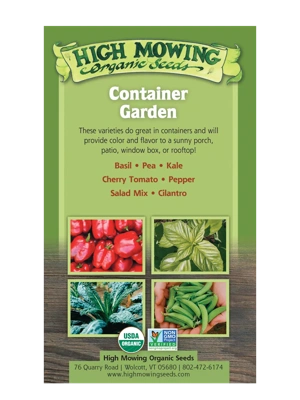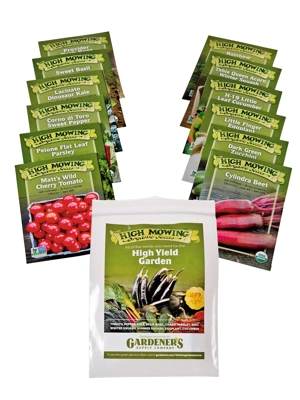Extend the Harvest With Fall Crops
Plant in the late summer to ensure another harvest before winter

Planting fall crops is a great way to get the most out of your garden space and increase your harvest. With just a little planning, you can extend the harvest long into the fall and even winter. When the cooler weather arrives, you'll be glad you planned ahead. Growing in the late summer and fall also comes with some major perks, including fewer problems with pests and diseases. Depending on where you live, however, the window for sowing fall crops can be short, and it's really important to start on time for an abundant harvest. In this article I'll offer a few tips to help plan your fall harvest.
Growing in Spring vs. Fall
Planting in spring is quite different from planting in summer. In spring, you're planting into cool soil that is getting warmer, and the days are getting longer. But in summer, you're planting into hot soil, and the days are getting shorter (and eventually, colder). This means that crops planted in summer will grow more slowly and take longer to mature than spring-planted crops. The difference is so marked that you need to add a "fall factor" — about two weeks — to the time it normally takes a crop to mature.
Light Frost vs. Hard Frost
A light frost occurs between 29 to 32 degrees F. and will only kill tender plants; a hard frost occurs when temperatures drop below 24 degrees F., which will cause severe damage to most vegetable plants.
The other big difference is that spring-planted crops must be protected from any stray late frosts. But with many fall crops, there is essentially a "hard stop" on the season: your first hard frost date. Many fall crops, such as broccoli and kale, are frost-tolerant or frost-hardy, and will actually improve in flavor and quality after a light frost. But growth will slow dramatically after frost, especially a hard frost. The goal is to have fall crops that are nearly mature by hard frost.
When to Sow: An example
Here in northern Vermont, our first frost happens around Sept. 30—but this is usually a light frost, and we aren't likely to have a hard frost until around Oct. 15. Because our frost-free growing season is only about 125 days, it's extra important to get fall varieties started on time.
Broccoli is popular here as a fall crop, because the quality is much better than in the spring. In order to figure out when to start, we need to do some math:
30 days from seed to seedling + 65 days from seedling to harvest + 15 days "fall factor" = 110 days from seed to harvest.
So,to harvest mature broccoli by Oct. 15, we need to sow seeds by the end of June at the latest.
Find Your average first hard frost date: Find frost dates by zip code.
Fall Crops to Start Indoors from Seed
The following crops should be started indoors in summer so you have beefy transplants. In general, they should be planted outside no later than two months before the first hard frost in your area. In some areas, you can buy seedlings at a garden center so you don't have to start your own from seed.
| Crop | When to start indoors (before planting out) | When to plant out (before first hard frost) | Days to maturity (from seeding, including "fall factor") | Fall harvest window |
|---|---|---|---|---|
| Broccoli | 4 weeks | 11 weeks | 110 | 1-2 weeks |
| Cabbage | 4 weeks | 12 weeks | 120 | 3-4 weeks |
| Cabbage, napa | 3-4 weeks | 10 weeks | 100 | 2-3 weeks |
| Cauliflower | 4 weeks | 12 weeks | 120 | 1-2 weeks |
| Kale | 4 weeks | 8 weeks | 85 | 2-3 months |
| Kohlrabi | 4 weeks | 10 weeks | 100 | 1-2 weeks |
| Lettuce, head | 3-4 weeks | 8 weeks | 85 | 1-2 weeks |
Fall Crops to Start Outdoors from Seed ("Direct Seeding")
The following crops should be sown directly in the ground on a regular basis so that they'll be continuously available through the fall. This is called "succession planting." For best results, the final planting or "succession" should be sown no later than two months before the first hard frost.
| Crop | When to sow (for continuous harvest) | Tips |
|---|---|---|
| Greens: salad mix, baby lettuce, Asian greens, mustards, claytonia, cress, beet greens and spinach | Every 1-3 weeks | May be cut 1" above soil line and allowed to re-grow for a second harvest |
| Roots: carrots, beets and turnips | Every 2-3 weeks | Cool hot soil by covering with cardboard for 3 days before sowing |
| Scallions | Every 2-4 weeks | May survive winter into the following year |
| Radishes | Every 10 days | Fast crop, may be mixed with carrot or beet seed to mark rows |
| Cilantro | Every 2-4 weeks | Coriander may be collected when plants go to seed |
Last updated: 01/04/2023
Print this Article:
Related items
Get the Dirt
Stay up to date on new articles and advice. Please fill out the information below.






